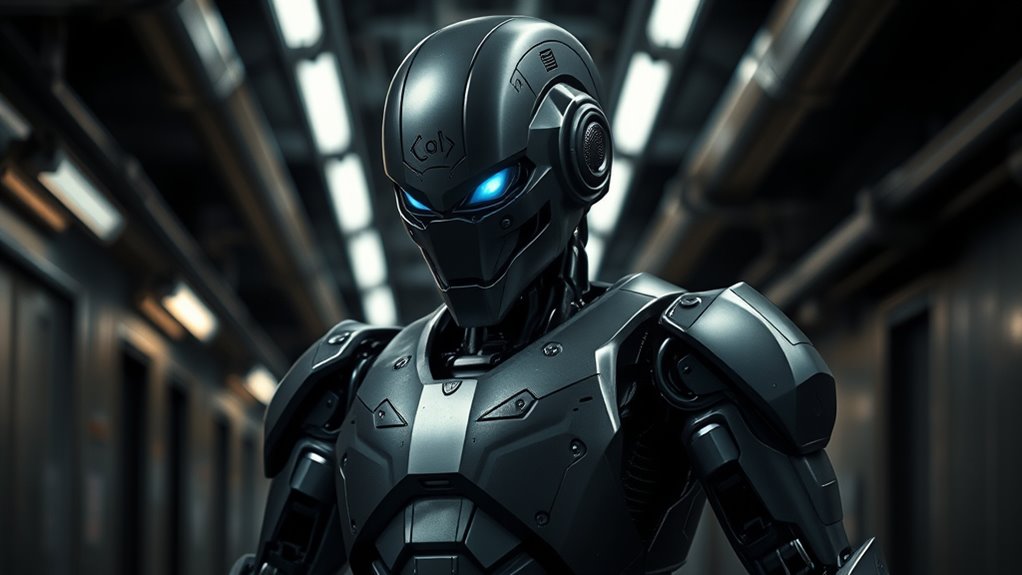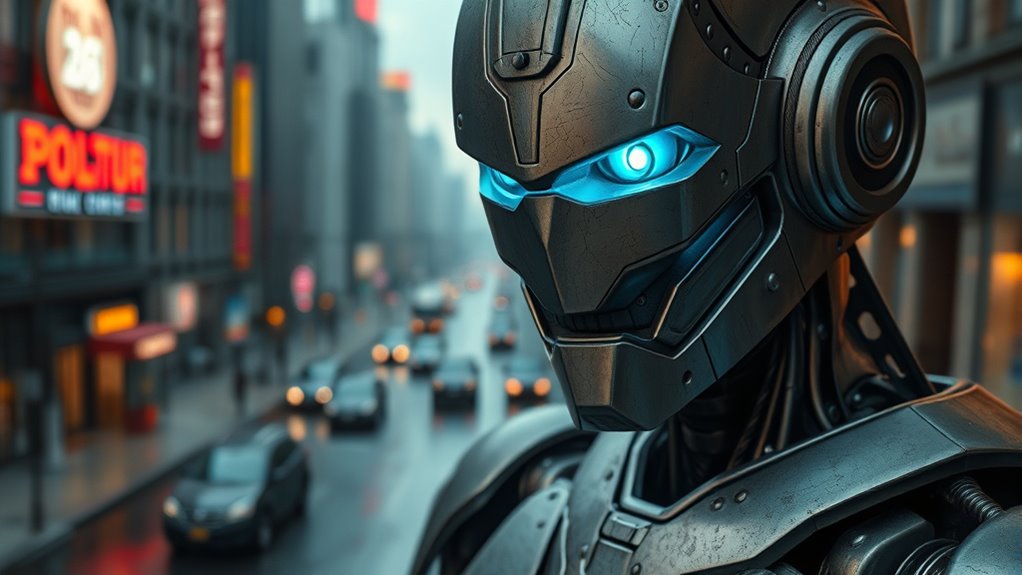Anti-hero robots like Murderbot challenge your expectations by maneuvering complex ethical dilemmas and showing emotional growth. They often struggle with morality, balancing their programming against personal feelings like empathy and remorse. These characters aren’t perfect but flawed, making them more relatable. Their moral ambiguity and emotional development highlight that heroism isn’t black-and-white. If you explore further, you’ll discover how these characters reflect deep human struggles with morality, identity, and purpose.
Key Takeaways
- Anti-hero robots like Murderbot navigate complex moral choices, balancing programming, survival, and innocent lives.
- They exhibit emotional growth, developing empathy, remorse, and a sense of identity beyond their original functions.
- These characters are flawed, morally ambiguous, and often struggle with their purpose, challenging traditional hero archetypes.
- Ethical dilemmas serve as catalysts for their emotional and moral evolution, emphasizing shades of gray in morality.
- Their development prompts reflection on human traits, exploring what it means to be moral, emotional, and truly human.

Have you ever wondered what happens when robots blur the line between hero and villain? It’s a fascinating question, especially when you consider characters like Murderbot. These anti-hero robots challenge traditional notions of morality and force you to rethink what makes someone truly good or bad. One of the most compelling aspects of these characters is how they navigate complex ethical dilemmas. Unlike straightforward heroes who always follow the rules, anti-hero robots often find themselves in situations where they must choose between conflicting moral priorities. For example, Murderbot might hesitate before taking violent action, weighing the consequences for innocent lives versus its own programming or survival. This internal conflict highlights how ethical dilemmas shape their behavior, making them more human and relatable despite their mechanical nature. It’s not just about following orders or programming; it’s about grappling with what’s right in morally ambiguous situations. As you observe these characters, you realize that their emotional development plays a *crucial* role in their actions. Unlike traditional robots, who operate solely based on logic and commands, anti-hero robots like Murderbot exhibit signs of emotional growth. They develop a sense of identity, question their purpose, and sometimes even feel empathy or remorse. This emotional evolution allows them to connect with humans on a deeper level, complicating the hero-villain dichotomy. You might see Murderbot struggle with feelings of loneliness, frustration, or guilt, which pushes it toward actions that aren’t strictly prescribed by its programming. It’s this internal struggle, driven by emotional development, that makes these characters so intriguing. They’re not perfect heroes; they’re flawed beings trying to find their place in a morally gray universe. This complexity forces you to rethink the traditional hero archetype and accept that sometimes, the most morally ambiguous characters are the ones who grow the most. It’s a reminder that ethical dilemmas aren’t black-and-white; they’re woven into every decision these robots face. Their emotional development isn’t just a narrative device—it’s a *vital* part of their transformation, making them more than mere machines. Instead, they become reflections of human struggles with morality, identity, and purpose. Recognizing the importance of ethical dilemmas helps to understand how these characters navigate their complex worlds. By examining these anti-hero robots, you’re invited to explore how ethics and emotions shape not only their actions but also our understanding of what it means to be a hero or villain. In the end, these characters challenge you to accept that morality often exists in shades of gray, especially when robots start to develop emotional depth and face tough ethical choices.
Frequently Asked Questions
How Do Anti-Hero Robots Differ From Traditional Hero Robots?
You’ll notice anti-hero robots differ from traditional hero robots because their robot morality often conflicts with their programming, leading them to act unpredictably. Unlike classic heroes, they might prioritize self-interest or personal goals, even if it means bending rules or breaking laws. These conflicts create complex characters who challenge our expectations, making their actions feel more realistic and relatable despite being robots.
What Ethical Dilemmas Do Anti-Hero Robots Typically Face?
You face ethical dilemmas like moral ambiguity and loyalty conflicts when dealing with anti-hero robots. They often struggle between following orders and doing what’s morally right, questioning authority and their purpose. This internal conflict challenges their programming, forcing you to contemplate whether they act out of self-interest or genuine morality. Their actions blur the line between heroism and selfishness, making their ethical choices complex and thought-provoking.
Are There Real-World Examples of Anti-Hero Robots?
Think of anti-hero robots as mirrors held up to our own flaws. While true anti-hero robots don’t exist yet, we see echoes in real-world AI systems with robot ethics and programming biases influencing their actions. Companies are developing AI that sometimes acts unpredictably, revealing the importance of addressing these biases. These examples highlight the need to carefully design robots to prevent unintended harm, much like shaping a character with a moral compass.
How Do Audiences Generally Perceive Anti-Hero Robots?
You’ll find that audiences often perceive anti-hero robots with a mix of empathy and intrigue. They’re drawn to characters with moral ambiguity, which makes them more relatable and complex. You might feel compassion for their struggles, even if they break rules or challenge norms. This blend of flaws and virtues creates a compelling connection, keeping you engaged as you explore their morally gray worlds.
What Psychological Traits Make Anti-Hero Robots Compelling Characters?
You’re captivated by anti-hero robots because their psychological traits are like a rollercoaster of moral ambiguity and emotional complexity, pulling you in with every twist. Their internal struggles, torn between duty and self-interest, make them unpredictable and deeply relatable. This mix of conflicting feelings creates a compelling depth that keeps you hooked, as you wonder whether they’ll do the right thing or bend the rules—making them irresistibly intriguing characters.
Conclusion
In the end, anti-hero robots like Murderbot remind us that appearances can be deceiving. Their flawed personalities and moral ambiguity show that even machines can have a heart—and doubts. You might think they’re just cold, calculating tools, but they often surprise you with their depth and humanity. Remember, sometimes it’s the quietest ones who have the most to say, proving that you shouldn’t judge a book by its cover.










